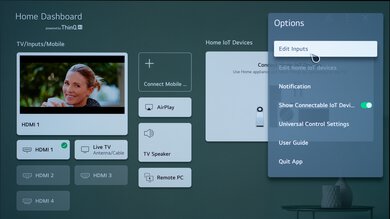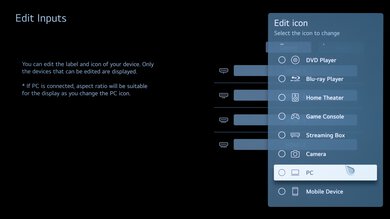This video is for the LG C1 OLED, but most of the settings are similar to the LG OLED Flex.
We used the following calibration settings to review the LG OLED Flex (42LX3QPAU). These settings should apply to most types of content, except for gaming or use as a PC monitor, which require a few additional changes listed below.
General Settings
SDR
For SDR content, we recommend choosing the 'Expert (Dark space, night)' picture mode, as it's the most accurate out of the box and allows for the most customization. If you watch in a brighter room, 'Expert (Bright space, daytime)' is almost as accurate.
From the 'Brightness' tab, we recommend setting the Adjust Contrast to '85' and Peak Brightness to 'High'. We also left Auto Dynamic Contrast disabled for most of our testing. From the 'Color' tab, we left Color Depth at '50' and Tint at '0'. We also left the Color Gamut set to 'Auto Detect', so the TV will choose the proper color gamut depending on the content. We set the Gamma to 2.2, as that is our target gamma. Finally, from the 'Clarity' tab, we left Sharpness at '25'. For most of our testing, we also kept Super Resolution, Noise Reduction, MPEG Noise Reduction, and Smooth Gradation settings disabled, but you should adjust these to your preference.
To adjust the TV's luminosity, you should adjust the OLED Pixel Brightness setting depending on your viewing conditions. Changing this setting does not have any impact on the overall picture quality.
HDR
HDR is automatically enabled for native apps. Once you start playing HDR content, some settings change automatically, including OLED Pixel Brightness. We recommend leaving these settings to their default settings in HDR. We recommend using the 'Cinema (User Settings)' Picture Mode, one of six modes you can choose from.
For HDR to work from external devices, the HDMI Deep Color option usually has to be set to '4k' from the 'HDMI Settings' menu for your input. Older devices may have compatibility issues if this option is left enabled, so we recommend only enabling this setting for devices that require it.
If HDR is too dim, enable Auto Dynamic Contrast or Dynamic Tone Mapping. These settings can help produce a brighter image but are also highly dependent on the content.
HDR White Point
The following are the results of calibrating the white balance of our unit to 6500K in HDR. They are provided for reference and shouldn't be copied as the calibration values vary per individual unit, even for the same model and same size as the TV we reviewed, due to manufacturing tolerances. If you want to try them, you'll need to enter all values shown, as all of them are active simultaneously. If you have worse picture quality, reset them to the default values.
Dolby Vision
The LG OLED Flex supports Dolby Vision from native apps and most external devices. As with normal HDR content, some settings change automatically when you start playing Dolby Vision content. We recommend leaving these settings as-is—do not copy our SDR settings over. We recommend the 'Cinema (User)' Picture Mode, but the 'Filmmaker Mode' also optimizes the content as the filmmaker intended. It's slightly more accurate but locks most settings, so you can't adjust it to your viewing preferences.
Motion Settings
Although we disable most motion-enhancing functions for most tests, you should adjust these to whatever looks best. Some settings, like motion interpolation, may need to be adjusted depending on the specific content you are watching.
Motion Interpolation
Although we usually leave these settings disabled during testing, you should adjust these settings to your liking, as different people prefer different levels of motion interpolation. To enable motion interpolation, set TruMotion to 'User Selection' and adjust the De-Blur and De-Judder sliders.
The OLED Motion setting enables the TV's black frame insertion (BFI) feature. Unlike the 2021 models, no 'High' or 'Low' setting exists. Enabling this feature introduces 60Hz flicker with all content. With this enabled, there's always judder when watching 24p content.
Judder
The LG OLED Flex can remove judder from all sources, but you have to enable the Real Cinema setting. Note that with OLED Motion enabled, there will always be 24p judder, even with Real Cinema enabled.
Gaming
From the base SDR and HDR settings, very few changes are required for a great gaming experience. When you enable Game Optimizer from the 'General' settings tab, the OLED Flex automatically enables all game-related settings. It should switch to the 'Game Optimizer' Picture Mode for low latency.
For HDR gaming, we recommend setting HDMI Deep Color to '4k' for the port you are using; otherwise, you might have some issues. If Instant Game Response is enabled, the TV should do this automatically.
Game Optimizer Settings
The Game Optimizer menu makes it easy to adjust all the gaming settings needed. You can enable the Game Optimizer setting or set the Picture Mode to 'Game Optimizer' to get low input lag. You can enable G-SYNC & VRR or AMD FreeSync Premium for variable refresh rate support from the Game Optimizer sub-menu. There's also a new Prevent Input Delay setting to get even lower input lag. Setting it to 'Boost' reduces the input lag by 2-3ms, with no noticeable change in picture quality or processing.
PC Gaming
For an optimal PC gaming experience and proper chroma 4:4:4 support, it's important to set the input icon to 'PC' for the HDMI port you are using. Once you've set the label, we recommend reapplying our base SDR or HDR settings, as the picture modes change when you set the label. This can be done from the 'Home Dashboard' menu. Depending on the format you are sending, it might also be necessary to set HDMI Deep Color to '4k'.
ARC/eARC
The LG OLED Flex supports both ARC and eARC, allowing it to pass high-quality audio from a connected source through to a connected soundbar or home theater receiver. To use it, you must set the HDMI Input Format to 'Bitstream', Digital Sound Output to 'Auto', and then enable eARC Support if your device supports it. To send the audio to your speaker system, you must then set Use Wired Speaker to either 'Optical Out Device' or 'HDMI(ARC) Device' device, depending on your connection method.
Other Settings
OLED Care
Although we don't expect this to be an issue for most people, burn-in is possible. You should be aware of a few options to ensure you get the most out of your new TV.
The Pixel Cleaning menu allows you to run a complete pixel refresh cycle, which takes about an hour. You can set it to run a short pixel refresh automatically after every 4 hours of cumulative usage once the TV is turned off or run it manually if you prefer.
As the name describes, the Screen Move setting moves the entire image a few pixels to one side and gradually shifts it in a different direction over time. This helps reduce burn-in effects from very small elements, like fine lines in a game HUD. We recommend leaving this enabled, as the screen shift is not very noticeable unless you're using the TV as a PC monitor.
Adjust Logo Brightness automatically dims the area around a logo when it detects one on the screen. This can cause problems with some games if the TV detects a UI element as a logo and dims it, so we recommend setting it to 'Low'.
Energy Saving
One of the first things we did was disable all the power saving and automatic image modes, as we don't want the TV to adjust the image during testing. For the OLED Flex, we disabled the Energy Saving and AI Service settings, and we also disabled Motion Eye Care in the Picture menu. You should adjust these settings to your preference.
White Balance Settings
The following are the results of our unit's white balance and colorspace calibration. They're provided for reference, and shouldn't be copied as the calibration values vary per individual unit even for the same model and size as the TV we reviewed due to manufacturing tolerances. If you want to try them you will need to enter all values shown, as all of them are active simultaneously. If you have worse picture quality, simply reset them to the default values.























































































































